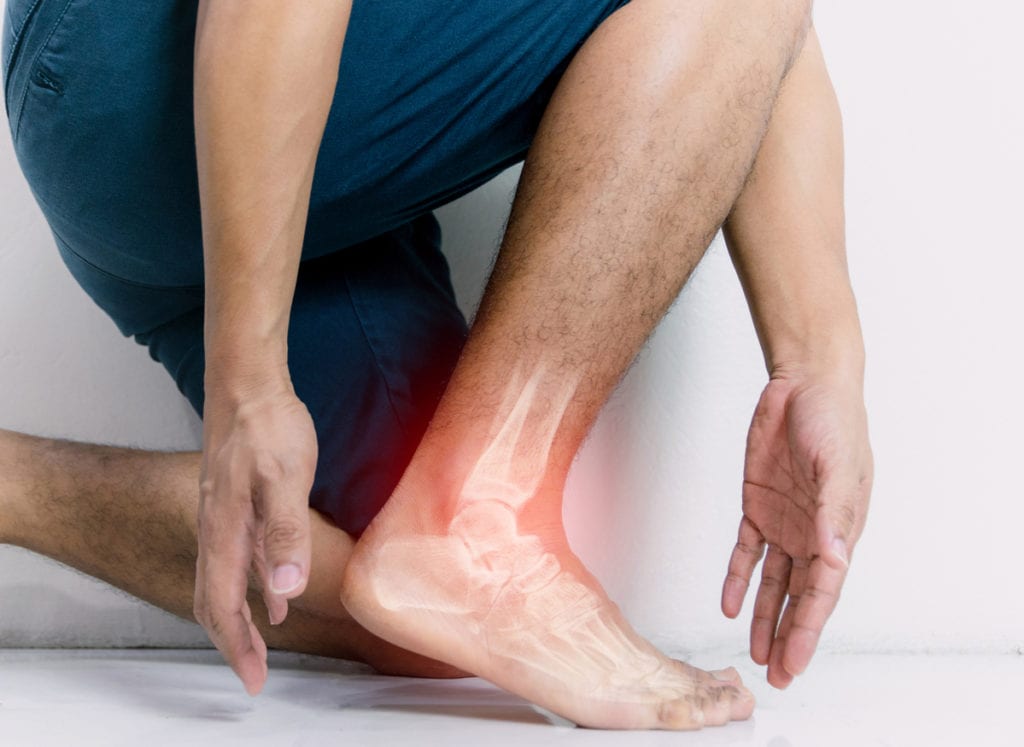FOOT / ANKLE
FOOT / ANKLE
The ankle joint, also known as the talocrural joint, is formed by the tibia, fibula, talus, and calcaneus (heel bone). Articular cartilage covers the ends of these bones, while the joint space is lined with the synovium, a thin membrane that provides cushioning and secretes synovial fluid for lubrication and reduced friction.
Ligaments play a crucial role in connecting and stabilizing these bones. The anterior tibiofibular ligament connects the tibia to the fibula, while the medial collateral (detoid) ligament and lateral collateral ligament provide additional support. Tendons, on the other hand, connect the lower leg muscles to the foot and ankle bones.

The foot is divided into three regions: the hindfoot, midfoot, and forefoot. The hindfoot extends from the ankle joint to the transverse tarsal joint, separating the rearfoot from the midfoot. The midfoot connects the forefoot to the hindfoot and includes muscles and ligaments. The forefoot comprises the metatarsals, phalanges (toe bones), and sesamoids (bones embedded within tendons or muscles to enhance their function).
Additionally, the foot has two columns: the medial column, consisting of the talus, navicular, medial cuneiform, 1st metatarsal, and great toe bones, and the lateral column, which includes the calcaneus, cuboid, and the 4th and 5th metatarsals.
Importance of Physiotherapy
Ankle and foot injuries are common due to the complexity of these structures. Fortunately, many conditions can be effectively treated with physical therapy. Physical therapists (PTs) are skilled in evaluating and treating movement dysfunctions and provide care for individuals of all ages with various muscle, joint, and neurological conditions.
We have successfully treated a range of ankle and foot conditions, including ankle pain, shin splints, ankle sprains, plantar fasciitis, Achilles tendonitis, excessive pronation, post-surgical conditions, and tibialis posterior tendonitis.
When it comes to treatment options, drugs, corticosteroid injections, surgery, and physical therapy are available. Physical therapy offers advantages such as no side effects, cost-effectiveness, support from clinical research, and customized treatment targeting the underlying cause of the condition.
Recover Process
During your recovery process, we prioritize pain relief, restoration of mobility or stability, increased strength, recovery of walking and functional skills, and promoting independent care.
Our approach to care includes a thorough biomechanical evaluation, extensive patient education, and the development of a personalized treatment plan. We utilize gentle hands-on techniques to relax muscles and effective joint mobilization techniques to reduce stiffness. Pain-relieving modalities like ice, heat, ultrasound, or electrical stimulation are employed, along with targeted stretching for tight muscles, walking retraining, balance exercises, and recommendations for shoe inserts (orthotics).
Sprains and strains are common injuries that affect the musculoskeletal system around joints. These injuries can occur due to various activities such as improper lifting, repetitive movements, or traumatic incidents like falls with twisting or pivoting motions.
Symptoms of sprains and strains are similar, leading to confusion between the two:
Sprain:
– Bruising (ecchymosis)
– Pain around the injured joint
– Swelling (edema)
– Limited flexibility and range of motion due to pain
Strain:
– Bruising (in cases of complete muscle tears)
– Muscle spasms
– Pain around the injured joint
– Swelling (edema)
– Limited flexibility and range of motion due to pain
What We Provide
Each individual’s treatment duration may vary, ranging from one or two visits to an extended care plan over weeks or months. If you are seeking relief from your ankle or foot condition and wish to address the root cause rather than just the symptoms, we are here to assist you.
Please contact us to schedule an appointment and take the first step toward a successful recovery. For additional information on ankle and foot conditions, you can also explore our Medical Library.